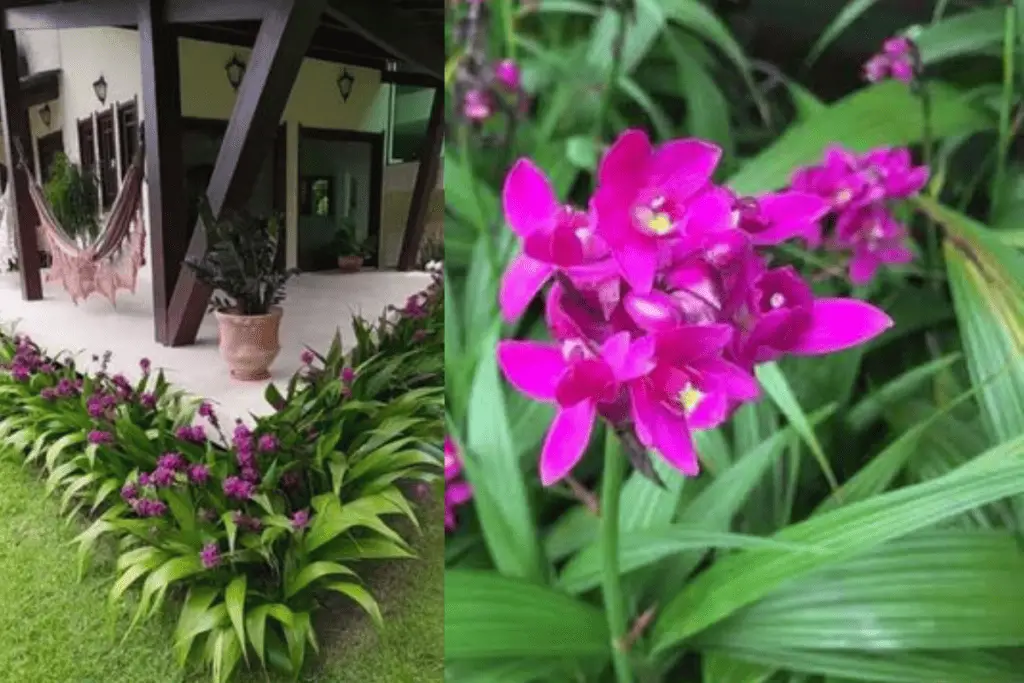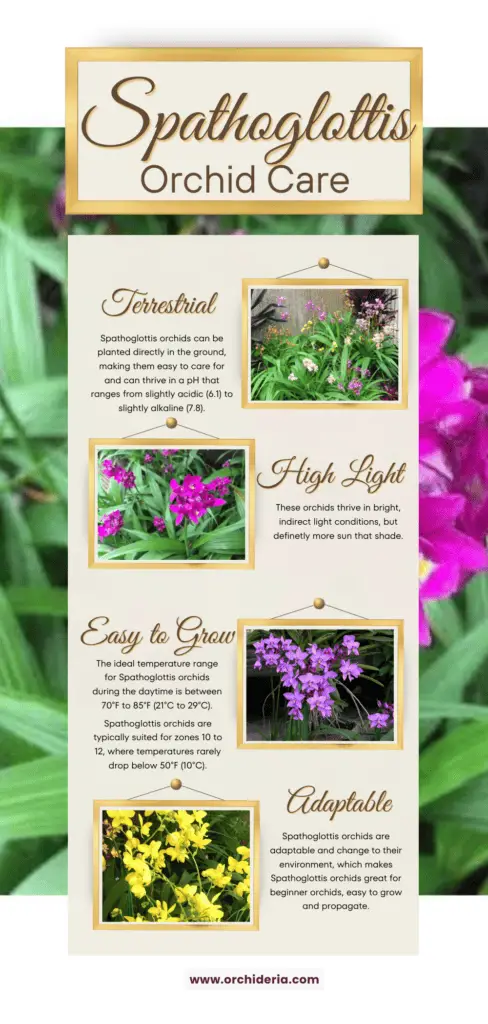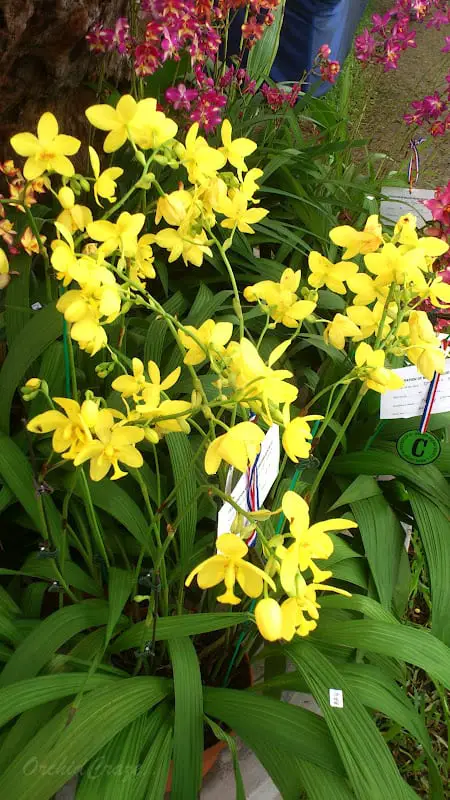Introduction
Spathoglottis orchids are evergreen, terrestrial plants. That’s right–they grow in the ground! Yipee! No more complicated orchid bark or sphagnum moss; no more special pots with holes… These orchids are beginner friendly and easy to grow. Spathglottis are commonly called “ground orchids”, but that’s misleading because about 30% of all orchids are terrestrial orchids) and a unique and fascinating addition to any orchid collection.
To properly grow Spathoglottis orchids, provide temperatures ranging from 70°F to 90°F (21°C to 32°C) during the day with a drop at night between 60°F to 70°F (15°C to 21°C), humidity between 50% to 70%, and apply moderate to high light levels. For this reason, Spathoglottis are the perfect beginner orchid to grow outdoors in zones 9-12.
I have had my eye on a few Spathoglottis species and they already have a reserved place in my greenhouse– once that is built. For now, I am doing all the research I can so when the time comes, I’ll know how to care for them. That’s how this article, the Spathoglottis Care Guide was “born”. If you don’t read anything else, just know this: unlike popular orchids like Phalaenopsis or Cattleya, Spathoglottis orchids are terrestrial orchids, meaning they grow in the ground rather than on trees or rocks.
The genus Spathoglottis comprises around 50 different species (49 species and 1 natural hybrid), each with its own distinct characteristics and beauty. These orchids vary in size, with some growing to be quite large while others remain more compact. In their adult phases, Spathoglottis orchids can reach a height of 1 to 3 feet, making them a substantial presence in any garden or indoor space. (Source )
)

Image Credit: Leandro Cunha (Instagram)
One of the most captivating features of Spathoglottis orchids is their flowers. These orchids produce stunning blooms that come in a variety of colors, including shades of purple, pink, yellow, and white. The flowers of Spathoglottis orchids are relatively large, typically measuring around 2 to 3 inches in diameter. Their vibrant colors and intricate patterns make them a popular choice among orchid enthusiasts.
Spathoglottis orchids will bloom in various seasons depending on their species: 1) late spring or early summer, 2) summer, 3) late summer or early fall, and 4) fall. Most all Spathoglottis orchids can remain in bloom during most all of the four blooming periods, which makes them a stunning flower to grow.
There are several popular varieties of spathoglottis orchids that are worth mentioning. One such variety is the Spathoglottis plicata, also known as the Philippine ground orchid. This variety is native to the Philippines and is known for its beautiful purple flowers. Another popular variety is the Spathoglottis kimballiana, which features stunning yellow flowers with red markings. A common sphathoglottis orchid in Brazil is the Spathoglottis Sorbet ‘Moonlit Grape’, commonly called the grape orchid, which has a sweet, grape-like scent.
In the following sections, I will delve deeper into the history behind spathoglottis orchids, their native growing conditions, and how to care for them to ensure their health and longevity. By understanding the unique characteristics and requirements of spathoglottis orchids, you will be better equipped to provide them with the care they need to thrive.

History behind Spathoglottis Orchids
The history behind Spathoglottis orchids is a fascinating tale of discovery and admiration. These unique orchids were first discovered by the renowned botanist Carl Ludwig Blume in the early 19th century. Blume, a Dutch botanist, came across these captivating orchids during his explorations in Southeast Asia. It was in the year 1825 that Blume officially described and named the genus Spathoglottis.
The name Spathoglottis comes from the Greek spathe, which means broad blade, and glottis, toungue. It is refrering ot the shape of the lip of the orchid, as compared to the rest of the petals.
The discovery of Spathoglottis orchids was significant for several reasons. Firstly, it introduced the world to a new group of orchids that were distinct from the epiphytic orchids commonly known at the time. Spathoglottis orchids stood out due to their terrestrial nature, growing in the ground rather than on trees or rocks. This unique characteristic captured the attention of orchid enthusiasts and collectors.
Over the years, Spathoglottis orchids have gained recognition and admiration for their beauty but mostly their resilience. Classified as esay to grow, these should be your first outdoor orchid to grow if you want to try terrestrial orchids. They have been awarded numerous accolades and prizes in orchid shows and competitions worldwide. Their vibrant and diverse flower colors, intricate patterns, and impressive size have made them a favorite among orchid lovers.
The history of Spathoglottis orchids is a testament to the enduring allure of these remarkable plants. From their discovery by Carl Ludwig Blume to their recognition in the world of orchid cultivation, Spathoglottis orchids continue to captivate and inspire with their unique beauty and fascinating history.
Spathoglottis Species and Hybrids
Spathoglottis orchids are from the Collabieae tribe and have 40 species. They are related to the Phaius and the Calanthe plants. According to Burleigh Park Orchids,
“There are basically two groups within the genus, one with evergreen foliage, the other, usually much smaller, being deciduous. Evergreens include Spathoglottis plicata and all its forms, the New Guinea species and Spathoglottis aurea, Spathoglottis kimballiana and species with large wide plicate leaves.The deciduous species include the smaller Spathoglottis affinis, Spathoglottis pubescens, Spathoglottis vanoverburghii, all of which tend to loose the old growth bulb and consist of a new seasonal, somewhat flat, round to angular tuber.” (Source )
)
Here are just a few:
| Name | Flower Size | Growing Conditions | Altitude, Temp, Etc |
| Spathoglottis aurea | spike 60 cm tall 4-10 flowered 7cm across | warm growing in between rocks | 750-1500 m 2460-5000 ft Borneo, Java, Malaysia, Sumatra |
| Spathoglottis ixioides | 1-3 flowered 2-3 cm across leaves 20 cm | cool growing Imitates Pleione conditions mossy rocks roadside banks | 1950 – 3650 m 6430 – 12,000 ft Bhutan, Sikkim |
| Spathoglottis petri | 70 cm tall inflorescence, 20+ flowers 4cm flower across | open grassy slopes | 700m , 2300 ft Vanatu, New Caledonia |
| Spathoglottis. plicata | hairy inflorescence up to 1m tall flowers 2.5 cm across | damp places Most widely spread variety | 0-500m, 1650 ft India, Southeast Asia, Philippines |
Native Growing Conditions (Where it’s Grown in the Wild)
Spathoglottis orchids are native to various regions in Southeast Asia, including countries such as Thailand, Malaysia, Indonesia, and the Philippines. These orchids thrive in tropical and subtropical climates, where they can be found growing in a range of habitats, from lowland forests to higher elevations.
One important factor to consider when growing Spathoglottis orchids is the hardiness zone. Spathoglottis orchids are typically suited for zones 10 to 12, where temperatures rarely drop below 50°F (10°C). In these regions, Spathoglottis orchids can be grown outdoors year-round, providing a stunning display of flowers throughout the year.
Unlike some other orchid species, Spathoglottis orchids are not evergreen. They are considered perennial, meaning they have a lifespan of more than two years. This characteristic allows them to continuously produce flowers without a dormancy period. As a result, Spathoglottis orchids can provide a consistent burst of color in your garden or indoor space and that’s why I have decided to grow mine as a border plant along my outside wall (I am in the southernmost part of Brazil, classified as a zone 9).
Altitude also plays a role in the native growing conditions of Spathoglottis orchids. These orchids can be found at various elevations, ranging from sea level to higher altitudes of up to 5,000 feet (1,500 meters). The ability of Spathoglottis orchids to adapt to different altitudes makes them versatile and suitable for cultivation in a wide range of environments.
In terms of temperature, Spathoglottis orchids prefer warm to hot conditions. They thrive in temperatures ranging from 70°F to 90°F (21°C to 32°C). These orchids are well-suited to the tropical climates of their native regions, where they can bask in the warmth and humidity. That is why they do well in full sun (as long as it isn’t scorching hot) to partial shade. The more shade you give your Spathoglottis orchid, the longer it will take to bloom.
In conclusion, Spathoglottis orchids are native to Southeast Asia, particularly countries like Thailand, Malaysia, Indonesia, and the Philippines. They are well-adapted to tropical and subtropical climates, with a preference for warm temperatures and high humidity. These orchids can be grown outdoors in hardiness zones 10 to 12, providing a continuous display of vibrant flowers throughout the year. Whether you’re a beginner or an experienced orchid enthusiast, Spathoglottis orchids are a delightful addition to any garden or indoor space. (Source)
Spatholgottis in the Greenhouse
When deciding to get a couple Spathoglottis orchids, place them inside on the orchid bench right by Dendrobiums and Cattleyas, since they love the bright, high level light. They also are very heavy feeders, so any application of fertilizer must be consistent and very frequent.

Light
Light is an essential factor to consider when caring for Spathoglottis orchids. These orchids thrive in bright, indirect light conditions, but definetly more sun that shade. They require a good amount of light to grow and bloom properly. Providing the right amount of light will ensure healthy growth and vibrant flowers.
When it comes to light intensity, Spathoglottis orchids prefer moderate to high levels. They can tolerate some direct sunlight, especially during the morning or late afternoon when the sun is not too intense. However, it’s important to avoid exposing them to direct sunlight during the hottest part of the day, as it can scorch their leaves.
Different species of Spathoglottis orchids may have varying light requirements. For example, Spathoglottis plicata, also known as the Philippine ground orchid, prefers slightly lower light levels compared to other species. On the other hand, Spathoglottis unguiculata, or the clawed orchid, can tolerate higher light levels.
Altitude also plays a role in the light conditions for Spathoglottis orchids. As you move to higher altitudes, the light intensity decreases due to factors such as cloud cover and atmospheric conditions. In mountainous regions, where Spathoglottis orchids can be found growing, the light may be filtered or diffused, providing a more gentle and indirect light. This can be beneficial for the orchids, as it reduces the risk of sunburn and allows for more even light distribution.
To provide the ideal light conditions for your Spathoglottis orchids, place them in a location where they can receive bright, indirect light for most of the day. A spot near a window with filtered sunlight or under a shade cloth in an outdoor setting can be suitable. Observing the leaves of your orchids can also give you an indication of whether they are receiving the right amount of light. Healthy leaves should be a vibrant green color, while leaves that are pale or yellowish may indicate insufficient light.
Temperature
Temperature plays a crucial role in the successful growth and blooming of Spathoglottis orchids. These tropical orchids thrive in warm temperatures, mimicking their natural habitat. The ideal temperature range for Spathoglottis orchids during the daytime is between 70°F to 85°F (21°C to 29°C). This temperature range provides the optimal conditions for their growth and encourages the development of vibrant flowers.
During the nighttime, it is important to provide slightly cooler temperatures to allow the orchids to rest and recover. The recommended temperature range for Spathoglottis orchids during the nighttime is between 60°F to 70°F (15°C to 21°C). This drop in temperature helps to simulate their natural environment and promotes healthy growth.
Maintaining a consistent temperature is essential for the overall well-being of Spathoglottis orchids. Drastic temperature fluctuations can stress the plants and hinder their growth. It is important to avoid exposing them to extreme temperatures, such as below 50°F (10°C) or above 95°F (35°C), as it can be detrimental to their health.
To ensure the ideal temperature conditions for your Spathoglottis orchids, it is recommended to place them in a location with stable temperatures and away from drafts or direct heat sources. Monitoring the temperature with a thermometer can help you maintain the optimal conditions for their growth.

Humidity
Humidity plays a crucial role in the successful growth and blooming of Spathoglottis orchids. These tropical plants thrive in environments with moderate to high humidity levels. The ideal humidity range for growing Spathoglottis orchids is between 50% to 70%.
To attain the optimal humidity level for your Spathoglottis orchids indoors, there are several methods you can employ. One effective way is to use a humidifier. A humidifier will help increase the moisture content in the air, creating a more suitable environment for the orchids. Place the humidifier near the orchids, ensuring that the mist is directed towards them.
Another method is to create a humidity tray. Fill a shallow tray with water and place it near the orchids. As the water evaporates, it will increase the humidity in the immediate vicinity. Be sure to monitor the water level and refill as needed. I wrote an article about a humidity tray that you can read here .
.
Misting the orchids with water is also beneficial in raising the humidity levels. Use a spray bottle to mist the leaves and aerial roots of the orchids. This should be done in the morning to allow the water to evaporate throughout the day.
Lastly, grouping the orchids together can help create a microclimate with higher humidity. When the plants are clustered, they naturally release moisture through transpiration, increasing the humidity around them. I have an entire article about humidity that you can read here . I also have another one about how I chose my indoor humidifier for my home office in this article
. I also have another one about how I chose my indoor humidifier for my home office in this article .
.
By maintaining the appropriate humidity range for your Spathoglottis orchids, you can ensure their optimal growth and encourage the development of beautiful, vibrant flowers.
Watering
Watering is a crucial aspect of caring for Spathoglottis orchids. To ensure the optimal growth and health of your orchids, it’s important to understand how to water them properly. The amount of water needed will vary depending on the size of the plant and the potting media used.
When watering Spathoglottis orchids, it’s best to use a measured approach. Start by thoroughly soaking the potting media until water drains out from the bottom of the pot. This ensures that the roots receive enough moisture.
The amount of water needed can vary, but a general guideline is to water the Spathoglottis orchids every 7 to 10 days during the growing season. In terms of measurements, aim to provide around 100-150 mL (3-5 ounces) of water per watering session for a tiny seedling. As the orchid grows, more water is needed.
Overwatering is a common problem with Spathoglottis orchids, but not as detrimental as it is with a Phalaenopsis orchid. So don’t be scared to pour water all over your orchid and water with ease. Just beware that if you tend to have a heavy hand at watering, it can lead to root rot and other issues. To avoid overwatering, make sure the potting media is well-draining and allows excess water to escape. Additionally, always check the moisture level of the potting media before watering again. Stick your finger about an inch into the media, and if it feels dry, it’s time to water.
Since some smaller varieties of Spathoglottis are deciduous during the colder months of the year, you may want to hold back of watering to the bare minimum (don’t kill your orchid by not watering it, but hold back considerably) since they don’t absorb much water in the colder climates.
If the kind of Spathoglottis orchid you have doesn’t drop it’s leaves, then keep your watering schedule constant during winter–damp but not overly wet. Some growers will not make a distinction between evergreen and delicious and hold back water all winter. Spathoglottis orchids are extremely adaptable and will grow well with this method too. In summer, there is no need to hold back on water supply.
On the other hand, dehydration can also be a problem. Signs of dehydration on s Spathoglottis orchid include brittle, wilted leaves, dry potting media, and lack of new growth. If you suspect your Spathoglottis orchid is dehydrated, increase the frequency of watering and consider misting the leaves to provide additional moisture.
PH Requirements of a Spathoglottis Orchid
Spathoglottis orchids can thrive in a pH that ranges from slightly acidic (6.1) to slightly alkaline (7.8). This is a great thing about their ability to adapt and change to their environment, which makes Spathoglottis orchids great for beginner orchids.
Slightly acid (6.1 – 6.5)
Neutral (6.6 – 7.3)
Slightly alkaline (7.4 – 7.8)
Repotting a Spathoglottis Orchid
When it comes to caring for your Spathoglottis orchid, repotting is an essential task that unlike epiphytic orchids, should not be done periodically. Repotting allows for the renewal of the potting media, provides fresh nutrients, and gives the orchid room to grow, yet since Spathoglottis are terrestrial orchids, they hate to be moved around and touched. Soil doesn’t degrade like orchid bark, and will need fresh organic matter on top of the soil to replenish lost nutrients.
The best time to repot a Spathoglottis orchid if you grow them in pots with orchid bark, is during its dormant period, which typically occurs in the late winter or early spring. This is great is you have a Spathoglottis that goes dormant, but some do not.
If it is a cold growing orchid, it will have a dormancy period, but warmer growing Spathoglottis orchids will not. During this dormant time, the orchid is not actively growing, making it less susceptible to stress and damage. It’s important to avoid repotting during the active growth phase, as this can disrupt the orchid’s development and potentially harm its delicate roots.
During the repotting session, there are a few key considerations to keep in mind. First, be sure that you need to repot. Most Spathoglotti orchids do better with smaller pots and only 2-3 leads than potted in large vases, which tend to allow much more foliage to grow instead of the flower spike.
Ensure that you have all the necessary tools and materials ready, including a clean pot, fresh potting media, like soil. It’s also important to handle the Spathoglottis orchid with care, avoiding any unnecessary damage to the leaves or roots.
When examining the roots of a Spathoglottis orchid, you should look for healthy, white or light-colored roots. These roots should be firm and plump, indicating good hydration and nutrient absorption. Avoid repotting if you notice any signs of rot, such as dark or mushy roots. In such cases, it’s best to trim away the affected roots before repotting the orchid.
Spathoglottis orchids dislike being disturbed during repotting, so it’s important to minimize any unnecessary handling or root manipulation. Avoid excessive shaking or pulling on the roots, as this can cause stress and damage. You don’t need to clean it thoroughly as you would an epiphytic orchid. This is a mistake a lot of people make… treating orchids all the same. The less you mess with the roots, the better. All the Spathoglottis orchids needs is more soil, and a quick rinse. Additionally, be cautious not to bury the orchid too deeply in the new potting media, as this can lead to suffocation and root rot. Aim to keep the base of the orchid slightly above the surface of the potting media.
When selecting a container for your Spathoglottis orchid, it’s best to choose one that provides adequate drainage, exactly like other orchids. Orchids prefer pots with multiple drainage holes to prevent water from pooling around the roots.
In terms of repotting media, Spathoglottis orchids prefer a well-draining mix that mimics their natural growing conditions. A typical repotting media for a terrestrial orchid like Spathoglottis consists of a combination of:
- garden soil,
- peat,
- leaf litter (or leaf mold),
- coarse perlite,
- river sand,
- large chunks of coconut husks,
- big charcoal chips,
- vermicompost…
- and anything high in natural compost.
Since these orchids are ground orchids, they will receive all their nutrients through the soil, depending heavily of the nutrients that fall from the canopy above them onto the forest floor, usually covered in leaf litter and moss. This degrades slowly and the water filters the nutrients directly to the underground roots.
The ratio of any combination of these will depend on your climate, but if you grow them in pots, you can use less soil and more husks. If in the ground, then it’s vice-versa. Stay away from sphagnum moss and common orchid bark potting media, since these will break down faster and raise the pH in the soil. This highly aerated , ground-mix allows for proper aeration and drainage, preventing the roots from becoming waterlogged. It’s important to note that the repotting media for Spathoglottis orchids differs from the normal potting media used for other types of orchids, such as epiphytic orchids.
Propagation
Propagation of Spathoglottis orchids is a simple and rewarding process that allows you to expand your collection or share the beauty of these orchids with others. One method of propagation is by dividing the bulbs. This can be done by gently pulling the bulbs apart, rather than using a knife to cut them. By pulling them apart, you can avoid any harm to the bulbs and ensure a successful propagation.
When replanting the bulbs, whether in a new pot or directly in the ground, it’s important to avoid planting them too far under the soil. Planting the Spathoglottis orchid bulb too deep can lead to rot and hinder its growth. Instead, aim to keep the bulb slightly above the surface of the soil or potting media. This will allow for proper air circulation and prevent excess moisture from accumulating around the bulb.
If you choose to propagate your Spathoglottis orchid by dividing the bulbs, it’s important to ensure that each division has a healthy portion of roots attached. This will increase the chances of successful establishment and growth. Once the bulbs have been divided and replanted, provide them with the same care and conditions as mature orchids, including appropriate light, temperature, humidity, and watering.

Best Fertilizer for Spathoglottis Orchids
To ensure the optimal growth and health of your Spathoglottis orchids grown in the ground, it is important to choose the right, balanced fertilizer. this means anything with equal rates of NPK, as in 20-20-20. This is because beside your Spathoglottis orchid, you will have another Spathoglottis orchid that may be in a different growth phase.
They are quick-growing orchids (if that is a thing) and propagate beside each other. It’s impossible to sort out one single plant and focus on the phase that it is in to specifically aid that phase. So in this sense, apply a constant but balanced fertilizer to the ground soil frequently. Since they are such prolific bloomers (remember, this is an orchid so when I say prolific, I mean a little faster than the others but still snail-paced) they will need constant help micro and macro nutrients in the fertilizer.
For all orchids, nitrogen, phosphorous and potassium are key nutrients that should be added to your Spathoglottis orchids, whether in pots or in the ground.
- Nitrogen is essential for promoting healthy leaf growth and overall plant vigor. Look for a fertilizer that has a higher nitrogen content to support the lush foliage of your orchids.
- Phosphorus aids in root development and encourages the production of beautiful flowers. Choose a fertilizer that contains a moderate amount of phosphorus to support the growth and blooming of your orchids.
- Potassium helps with overall plant health, disease resistance, and flower production.
In addition to these primary nutrients, Spathoglottis orchids can benefit from trace elements such as iron, magnesium, and calcium. These micronutrients are essential for healthy growth and can be found in specialized orchid fertilizers.
Don’t Stop Learning!
If you want to be included in more information and get a 14-page fertilization guide, please sign up for my newsletter. I don’t spam, but send emails out bi-monthly with some curious topics of interest. If you want more information, click here to go to a specific page on this website where I explain it more in detail.

Also, if you are looking for an orchid journal to keep your notes specifically about orchid care, check out my 2 solutions for that on this page. If note-keeping isn’t your thing, then there is a free excel spreadsheet that you can download. Click here for more information on how to do that.
If you subscribe to my newsletter, I will send you a 14-page guide on the main tips of orchid fertilizer. It is downloadable and you can print it out on your computer. I designed the guide to double up as a coloring book, just to make it fun.
Main Problems for Spathoglottis Orchids
Spathoglottis orchids, like any other terrestrial plant, can face their fair share of problems and pests. It’s important to be aware of these issues and understand their weak points as orchids. One common problem for Spathoglottis orchids is root rot. This occurs when the roots are constantly wet and not given enough time to dry out. Overwatering or poor drainage can lead to root rot, causing the roots to become mushy and eventually die. To prevent this, it’s crucial to water the orchids properly, allowing the top inch of soil to dry out before watering again.
Another problem that Spathoglottis orchids may encounter is fungal and bacterial infections. These can manifest as spots or discoloration on the leaves, stems, or flowers. Fungal infections thrive in humid conditions, so it’s important to maintain proper air circulation and avoid overcrowding the plants. Regularly inspecting the orchids for any signs of infection and promptly treating them with appropriate fungicides or bactericides can help prevent the spread of these diseases.
Since Spathoglottis orchids are commonly outside, any critters that love to chew on the leaves and flower stalks are going to be a problem, such as spider mites, mealybugs, scale, fungus gnats, snails, slugs, and caterpillars.
- Spider Mites: These tiny arachnids can cause significant damage to the plant. They feed on the plant’s sap, causing yellowing or browning of leaves.
- Mealybugs: These are small, white insects that feed on plant juices. They can cause loss of leaves, buds, and flowers, and also weaken the plants.
- Scale: These are small insects that attach themselves to the plant and feed on its sap. They can cause yellowing of leaves and overall weakening of the plant.
- Fungus Gnats: These small, dark, short-lived gnats are similar to fruit flies. The larvae feed on plant roots, which can stunt growth and cause yellowing of leaves.
- Caterpillars: These pests can chew on leaves and flowers, causing significant damage.
- Snails and Slugs: These pests can eat large portions of your orchid plant, especially the leaves.These pests feed on the plant sap, causing damage to the leaves and flowers. Regularly inspecting the orchids for any signs of pest infestation and taking immediate action, such as using insecticidal soaps or neem oil, can help control these pests.
By being proactive and addressing these main problems and pests, you can ensure the health and vitality of your Spathoglottis orchids, allowing them to thrive and bloom beautifully.
In all, I hope this care guide helped. If you have any questions, please type them in the comment section below. Happy Cultivating!!

